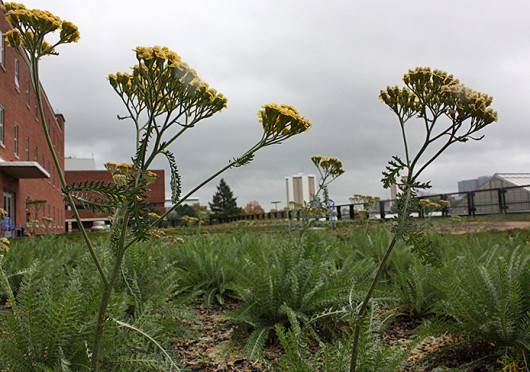
The green walkout roof of Howlett Hall, which is located at 2001 Fyffe Road, opened at the beginning of October.
Credit: Ethan Day / Lantern photographer
It took about three and a half years of planning and three weeks of renovations to make Howlett Hall’s walkout roof green.
What was once a tar and chip rooftop now helps mitigate storm water and minimize heat gain for the section of building it covers, said Megan Welsh, certified green roof professional of Higher Ground Green Roofs, LLC.
Welsh, an OSU alumna, graduated in 2011 with a degree in construction management and horticulture. She served as the project coordinator for the installation of the green roof and helped with raising funds, designing concepts and coordinating construction.
When Howlett was dedicated in 1967, the area that houses the new green roof was structurally designed to hold a green house, said Mary Maloney, director of the Chadwick Arboretum and Learning Gardens.
The green roof is part of Chadwick Arboretum and Learning Gardens and will help to keep chemicals and toxins from being collected by rainfall before making their way to local bodies of water, Welsh said. She added that the addition cost more than $400,000.
“This green roof in particular is saving about 200,000 gallons of polluted water per year from going into the Olentangy River,” Welsh said. Howlett is roughly a quarter of a mile from the Olentangy River.
In addition, the botanical canopy will “reduce the cost to heat and cool the Food Processing Pilot Plant below,” Maloney said.
The life of the roof should also be extended for about 20 years with the new roof, she said.
To prepare for the green roof installation, the roof had to pass a leak detection test, Welsh said. Then several layers of material were applied for protection, drainage and to help with plant growth. There are now different varieties of sedum, black-eyed susans, yarrow, thyme and prairie dropseed plants growing, she said.
Not only does the new roof help conserve water and energy, but some say it is aesthetically pleasing.
“It’s a very nice looking arrangement. It has a slight abstract sense to it,” said Pablo Jourdan, director of the Ornamental Plant Germplasm Center.
The cost of the renovations included the green roof itself, design and contract work and the installation of a guardrail and a ramp to make the entrance wheelchair accessible, Maloney said. The entrance ramp is still under construction.
To help pay for the transformation, a $102,000 grant was procured from the Environmental Protection Agency and the roof project also received a $60,000 grant from the President’s and Provost’s Council on Sustainability, according to the Department of Horticulture and Crop Science website, Maloney said. In addition, Maloney said she raised private funds.
“I’m not completely finished with my fundraising yet, but the substantial portion of it is done,” Maloney said, adding it is mostly items like tables and benches that have not yet been funded.
Fundraising isn’t the only process still unfolding though — Maloney said she wants to add additional tables and chairs to offer students a place to hang out or do schoolwork, she said.
Maloney added that the roof is easily accessible.
“Anytime Howlett Hall is open, you can just walk in the front door, walk through the building and walk onto the green roof,” Maloney said.
Even as developments continue, the green roof will remain active through the fall months, Welsh said. The garden will be dormant during the winter and become active again in the springtime, Welsh said. When it is thriving, the garden is sustained by rainfall twice over.
“We catch rainwater in a cistern next door, and then we pump it over. So when we do have to irrigate, it’s with rainwater reused,” Welsh said.
The benefits to the Chadwick Arboretum and Learning Gardens and the local environment help demonstrate the importance of having green roofs, Jourdan said.
“There is nothing that has to validate the value of green roofs. I think the issue is that we need more of them,” Jourdan said, “It’s a great example of having something in the university so that we can begin to gain those benefits.”


